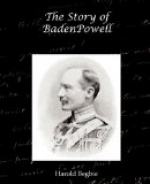Buluwayo, prior to the time of Sir Frederick Carrington’s arrival, contained about seven hundred women and children and some eight hundred men. The women and children were accommodated in a laager of waggons built up with sacks full of earth, and further protected from assault by a twenty or thirty yards’ entanglement of barbed wire with a sprinkling of broken bottles on the ground. The eight hundred men were organised in troops, and were armed and horsed in an incredibly short space of time.
Outside the town, on the north, south, and east, lay more than seven thousand Matabele, two thousand of whom were armed with Martini-Henry rifles, while the others possessed Lee-Metfords, elephant guns, Tower muskets, and blunderbusses, besides their own native assegais, knobkerries, and battle-axes. This formidable force was further strengthened by the desertion of a hundred Native Police, who took with them to the enemy their Winchester repeaters. Thus it will be seen that all the odds were in favour of the Matabele, but it is only when the odds are overwhelming against him that the Englishman feels he must buck up, and Buluwayo was fortunate enough to possess men of the true breed. Among these let us make special mention of the Hon. Maurice Gifford, who lost an arm in a gallant dash upon the besiegers[1]—a man “for whom rough miners and impetuous cowboys work like well-broken hounds”; Mr. F.C. Selous, hunter and explorer; Colonel Napier, and Captain MacFarlane. These men gave the enemy no rest, and by repeated attacks at last rid the town of any immediate danger of being rushed by the blacks.




